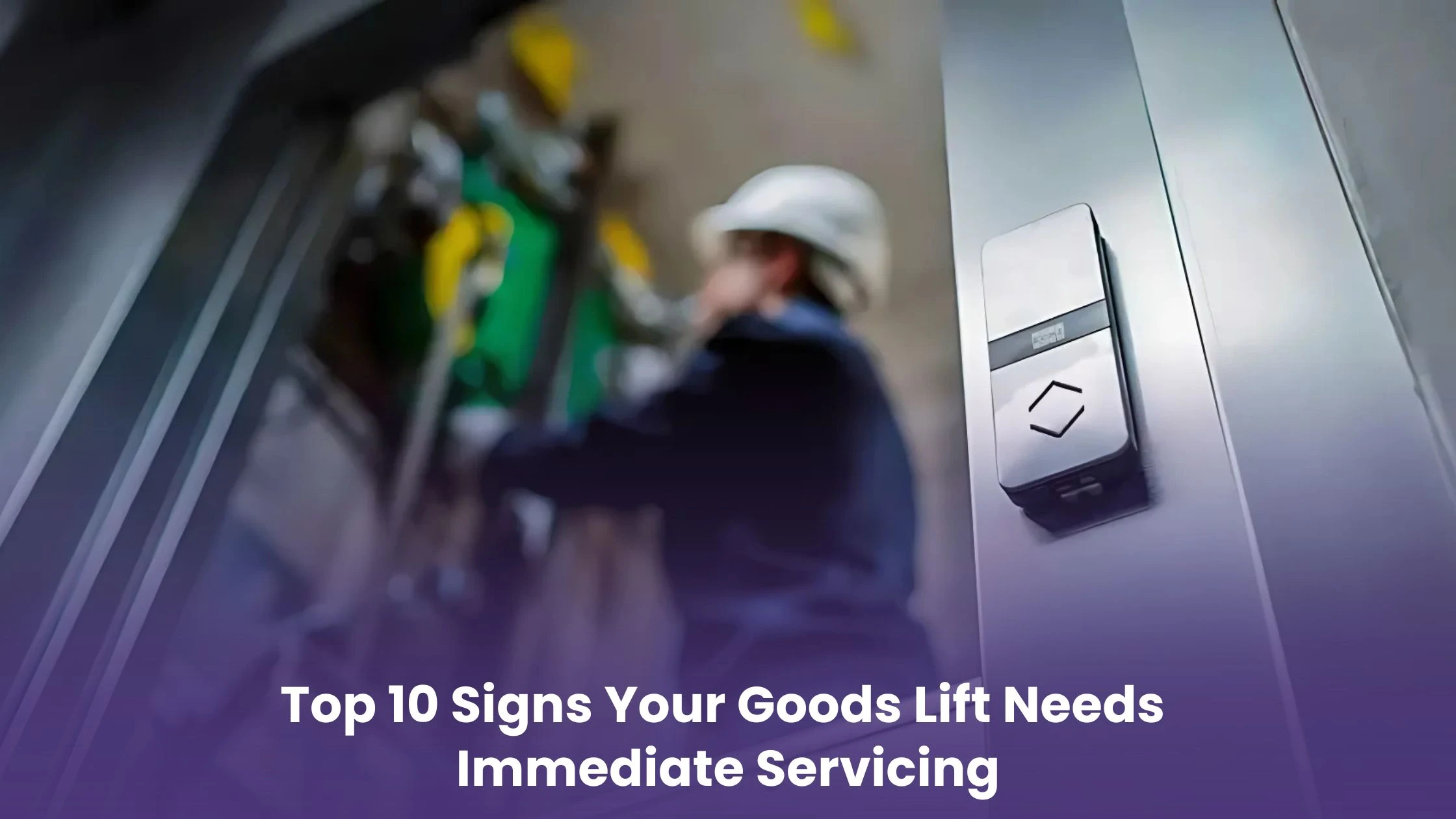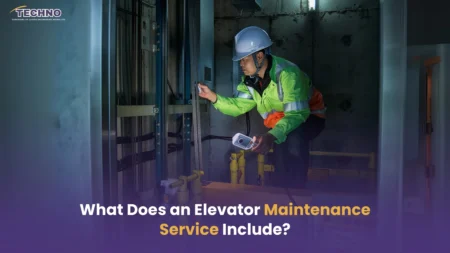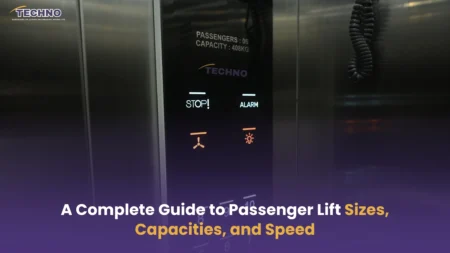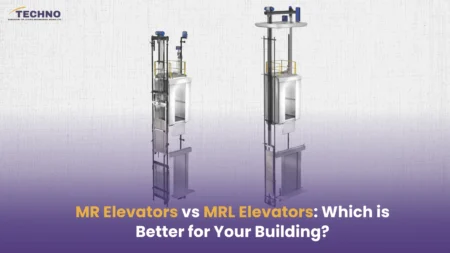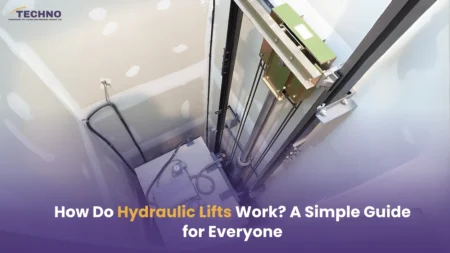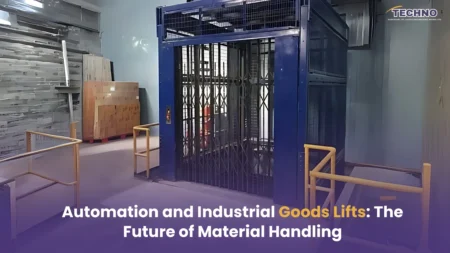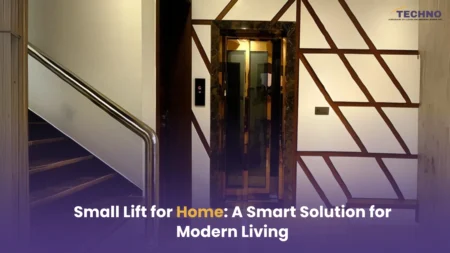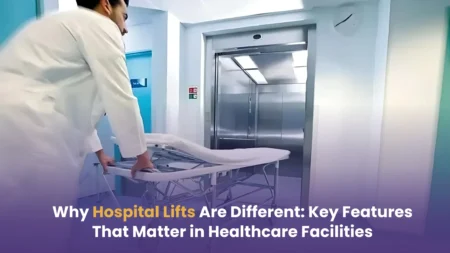In a busy commercial environment, a goods lift is not just another piece of machinery, it is an important link in your daily operations. A malfunction of your industrial goods lift can have serious ramifications. Whether your commercial premises involve a warehouse, a retail operation, or hospital back-of-house logistics, the malfunction of your goods lift will inadvertently result in bottlenecks, damage to products in the case of commercial premises involving perishable goods, or worse, the potential risk to life.
Usually, a failure does not happen overnight. There are usually subtle signs that you and other operators will notice.
Sometimes people are not aware of what the early signs are and what they mean. So, what should be alerted to?
Let’s decode the common signs that your goods lift requires urgent servicing, and what indicators you can identify before serious failures occur.
1. Unwelcome Sounds: What They Mean and When to be Concerned.
Goods lifts are designed from the ground up to be silent and smooth in operation. Hence, when noisy screeching, clanking, and/or grinding come into play, it’s a problem, not just an annoyance.
What does this mean?
- Screeching could indicate so mounted guide rails are mounted or misaligned.
- Grinding could point to problems with the motor or gears, which may be worn.
- Clanking may point to a component that is loose within the shaft.
Do not wait until a nagging noise develops into a loud one. No particular noise is good, and it shouldn’t be ignored. These noises can be the first signs your goods lift needs repair or to be checked immediately. A small fault in the traction system or cabin guide can develop into a full breakdown of the system altogether.
2. Sluggish or Jerky Movement: A Sign of Mechanical Trouble
A well-maintained Goods Lift should move with constant speed and smoothness. If the movement becomes jerky or unusually slow, mechanical parts may be under stress.
Possible causes include:
- Worn-out bearings
- Faulty motor or VFD drive
- Low hydraulic fluid levels in certain models
Such issues can compromise load balancing and lead to safety failures. Timely goods lift servicing can restore normal operation and prevent load mishandling.
3. Inconsistent Leveling: Why It's a Serious Safety Hazard
Leveling issues where the lift stops above or below the floor level aren’t just inconvenient. They’re dangerous. Especially in facilities where trolleys or carts are wheeled in and out, inconsistent leveling can cause tip-overs, injuries, or damage to goods.
Common causes include:
- Faulty sensors
- Control system malfunctions
- Brake wear
Inconsistent leveling is one of the most overlooked goods elevator problems, but one of the most urgent to address.
4. Frequent Breakdowns: When Temporary Fixes Aren’t Enough
Is your lift down more often than it’s running? Repeated stoppages often point to a deeper issue.
If you find yourself frequently calling for urgent goods lift repair, it’s time to stop patching and start investigating. A professional technician can do a full goods lift inspection and identify chronic failures, whether electrical, mechanical, or structural.
Regular goods lift maintenance minimizes emergency callouts and extends the life of your equipment.
5. Unresponsive Controls or Delayed Operation
If you’re pressing a button and waiting too long, or worse, nothing happens at all, it’s more than a minor glitch.
This could point to:
- Wiring issues
- Faulty circuit boards
- Sensor or relay failures
This isn’t just an operational delay. In emergency scenarios, a non-responsive lift can escalate risks. Never delay servicing when your controls start acting up.
6. Safety Features Not Working Properly: A Hidden Risk
From overload indicators to emergency stop buttons, modern lifts are equipped with several safety features. But how often do you check if they’re functioning?
If the alarm system doesn’t sound, or the door interlock isn’t reliable, your goods lift is no longer compliant or safe.
A routine goods lift safety check ensures all protective mechanisms are in place. Ignoring these can have legal and safety consequences.
7. Visual Inspection Checklist: What to Look for in a Malfunctioning Lift
You don’t need to be an engineer to spot early warning signs. Here’s what building managers and staff can routinely check:
- Door alignment issues: Gaps or slamming doors
- Oil leaks: Especially near the pit area
- Cable wear: Frayed or loose cables
- Rust or corrosion: On doors or inside the shaft
- Display errors: Fault codes or flickering control panels
These signs indicate your system may require professional goods lift troubleshooting.
8. Why Preventive Maintenance Matters More Than Emergency Repairs
Waiting for something to break is the most expensive way to manage a goods lift. Preventive maintenance not only keeps operations smooth, but it also protects your long-term investment.
Benefits of preventive maintenance:
- Reduces breakdown frequency
- Ensures legal compliance
- Extends system life
- Improves energy efficiency
Whether you’re using a goods lift for shop, storage facility, or multi-floor warehouse, having a structured maintenance plan is smarter than emergency fixes.
9. How to Choose the Right Technician for Lift Servicing
When it comes to commercial lift servicing, not every technician is the same. You need someone who understands both the mechanical and electronic components of modern elevators.
Look for:
- Experience with your lift’s make/model
- Certification in lift servicing
- A clear track record of industrial goods lift maintenance
- Availability for emergency service
- Access to genuine replacement parts
Don’t just go for the lowest quote. The right technician can spot minor issues before they turn critical.
10. Common Causes of Goods Lift Failures and How to Prevent Them
Understanding why lifts fail can help prevent future issues. Here are a few common culprits:
- Overloading: Exceeding weight limits repeatedly weakens the suspension and motor.
- Neglected servicing: Skipping regular maintenance leads to compounded wear.
- Improper use: Unauthorized tampering or rough handling by staff.
- Old systems: Outdated components fail more often and are harder to source.
To avoid these, invest in regular inspections and work with reputable goods elevator manufacturers who offer after-sales support.
So, When to Service Goods Lift?
If you’ve noticed any of the signs above, don’t wait. The earlier you act, the better you protect your operations, staff, and equipment. Timely goods lift servicing can mean the difference between a minor repair and a full system replacement.
Whether you’re managing a society upgrade, handling hospital logistics, or setting up a goods lift for shop use, reliable performance should never be optional.
The smarter choice? Don’t wait for a breakdown. Stay one step ahead.
At Techno Elevators, we believe a lift is not just a machine, it’s a promise of safety, efficiency, and durability. If you’re seeing even one of these goods lift inspection signs, it’s time to act.
Let’s keep your operations moving seamlessly, safely, and smartly.
Top Industries that rely on goods lifts for efficient operations
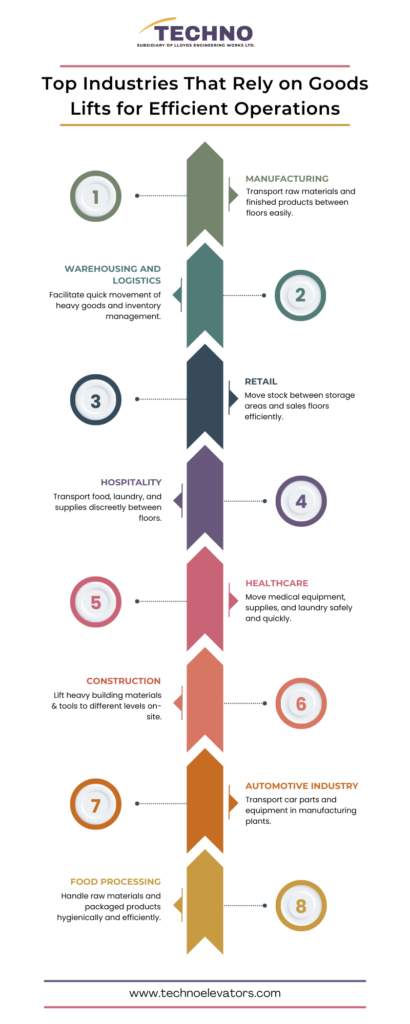
From manufacturing to hospitality, goods lifts play a crucial role in streamlining operations across various industries. This infographic highlights the top sectors where goods lifts are essential for productivity, safety, and smooth logistics.
Techno Elevators, one of the top elevator companies in India, provides robust and customized goods lift solutions trusted by leading businesses nationwide. Our lifts are designed to meet the specific needs of each industry, ensuring safe and efficient material handling.

